Unit – 4
Content
Function of two variables- R denotes the set of real numbers. Let’s D is a collection of pairs of real numbers (x , y), which means D is a subset of R × R.
Then a real valued function of two variables of f is a rule that assign to each point (x,y) in D a unique real number denoted by f(x,y).
The set D is called the domain of f.
The set [ f(x,y) : (x,y) belongs to D ], which is the set of values the function f takes, is called range of f.
Here we genrally use the letter z to denote the value that a function of two variables takes,
Then we will have,
z = f(x, y)
Here we will call that z is the dependent variable and x and y are independent variables.
Example-1: The area of a rectangular figure whose length is l and breadth is b, given by l × b.
Here independent variables are l and b, but dependent variable is area.
Example-2: the volume of a cylinder is given by πr²h, where r is the radius and h is the height of the cylinder.
In which radius and height are independent variables and volume is dependent.
Example-3: the volume of cuboid is given by l × b× h. Where l, b and h are the length, breadth and height respectively.
L , b and h are independent variable and volume of cuboid is dependent variable.
Limits-
The function f(x,y) is said to tend to limit ‘l’ , as x →a and y→b Iff the limit is dependent on point (x,y) as x →a and y→b
We can write this as,

Example-1: evaluate the 
Sol. We can simply find the solution as follows,

Example-2: evaluate 
Sol.
 -6.
-6.
Example-3: evaluate 
Sol.

Conitinuity –
At point (a,b) , a function f(x,y) is said to be continuous if,

Working rule for continuity-
Step-1: f(a,b) should be well defined.
Step-2:  should exist.
should exist.
Step-3: 
Example-1: Test the continuity of the following function-

Sol. (1) the function is well defined at (0,0)
(2) check for the second step,


That means the limit exists at (0,0)
Now check step-3:


So that the function is continuous at origin.
Example-2: check for the continuity of the following function at origin,

Sol. (1) Here the function is well defined at (0,0)
(2) check for second step-

Limit f is not unique for different values of m
So that the limit does not exists.
Therefore the function is not continuous at origin.
Steps to check-
Step-1: find the value of f(x,y) along x →a and y→b
Step-2: find the value of f(x,y) along x →b and y→a
Note- if the values in step -1 and step-2 are same then we can say that the limits exist otherwise not.
Step-3: if a →0 and b→0 then find the limit along y =mx , if the value does not contain m then limit exist, If it contains m then the limit does not exist.
Note-1- put x = 0 and y = 0 in f , then find f1
2 - Put y = 0 and x = 0 In f then find x2
If f1 and f2 are equal then limit exist otherwise not.
3- put y = mx then find f3
If f1 = f2 ≠f3, limit does not exist.
4- put y = mx² and find f4,
If f1 = f2 = f3 ≠ f4 , limit does not exist
If f1 = f2 = f3 = f4 , limit exist.
Example-1: Evaluate 
Sol . 1. 
2. 
Here f1 = f2
3. Now put y = mx, we get

Here f1 = f2 = f3
Now put y = mx²
4. 
Therefore ,
F1 = f2 = f3 =f4
We can say that the limit exists with 0.
Example-2: evaluate the following-

Sol. First we will calculate f1 –
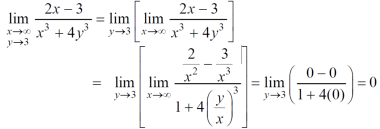
Here we see that f1 = 0
Now find f2,

Here , f1 = f2
Therefore the limit exists with value 0.
First order partial differentiation-
Let f(x , y) be a function of two variables. Then the partial derivative of this function with respect to x can be written as  and defined as follows:
and defined as follows:
 =
= 
Now the partial derivative of f with respect to f can be written as  and defined as follows:
and defined as follows:
 =
= 
Note: a. While calculating partial derivatives treat all independent variables, other than the variable with respect to which we are differentiating , as constant.
b. We apply all differentiation rules.
Higher order partial differentiation-
Let f(x , y) be a function of two variables. Then its second-order partial derivatives, third order partial derivatives and so on are referred as higher order partial derivatives.
These are second order four partial derivatives:
(a)  =
= 
(b)  =
= 
(c)  =
= 
(d)  =
= 
b and c are known as mixed partial derivatives.
Similarly we can find the other higher order derivatives.
Example-1: - Calculate  and
and  for the following function
for the following function
f(x , y) = 3x³-5y²+2xy-8x+4y-20
Sol. To calculate  treat the variable y as a constant, then differentiate f(x,y) with respect to x by using differentiation rules,
treat the variable y as a constant, then differentiate f(x,y) with respect to x by using differentiation rules,
 =
=  [3x³-5y²+2xy-8x+4y-20]
[3x³-5y²+2xy-8x+4y-20]
=  3x³] -
3x³] -  5y²] +
5y²] +  [2xy] -
[2xy] - 8x] +
8x] + 4y] -
4y] -  20]
20]
= 9x² - 0 + 2y – 8 + 0 – 0
= 9x² + 2y – 8
Similarly partial derivative of f(x,y) with respect to y is:
 =
=  [3x³-5y²+2xy-8x+4y-20]
[3x³-5y²+2xy-8x+4y-20]
=  3x³] -
3x³] -  5y²] +
5y²] +  [2xy] -
[2xy] - 8x] +
8x] + 4y] -
4y] -  20]
20]
= 0 – 10y + 2x – 0 + 4 – 0
= 2x – 10y +4.
Example-2: Calculate  and
and  for the following function
for the following function
f( x, y) = sin(y²x + 5x – 8)
Sol. To calculate  treat the variable y as a constant, then differentiate f(x,y) with respect to x by using differentiation rules,
treat the variable y as a constant, then differentiate f(x,y) with respect to x by using differentiation rules,

 [sin(y²x + 5x – 8)]
[sin(y²x + 5x – 8)]
= cos(y²x + 5x – 8) (y²x + 5x – 8)
(y²x + 5x – 8)
= (y² + 50) cos(y²x + 5x – 8)
Similarly partial derivative of f(x,y) with respect to y is,

 [sin(y²x + 5x – 8)]
[sin(y²x + 5x – 8)]
= cos(y²x + 5x – 8) (y²x + 5x – 8)
(y²x + 5x – 8)
= 2xy cos(y²x + 5x – 8)
Example-3: Obtain all the second order partial derivative of the function:
f( x, y) = ( x³y² - xy⁵)
Sol.  3x²y² - y⁵,
3x²y² - y⁵,  2x³y – 5xy⁴,
2x³y – 5xy⁴,
 =
=  = 6xy²
= 6xy²
 =
=  2x³ - 20xy³
2x³ - 20xy³
 =
=  = 6x²y – 5y⁴
= 6x²y – 5y⁴
 =
=  = 6x²y - 5y⁴
= 6x²y - 5y⁴
Example-4: Find

Sol. First we will differentiate partially with repsect to r,


Now differentiate partially with respect to θ, we get


Example-5: if,

Then find.

Sol-
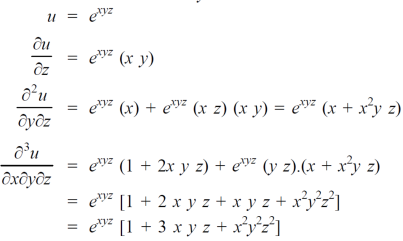
If a function f(x,y) is continuous and smooth to second order , then the order of operation of the partial derivatives does not matter and

Which is also known as Clairaut’s theorem.
Example: verify mixed derivative theorem for f(x,y) = x 
Sol. First we will find first order derivative,

Now second order derivative,

We can clearly see that,
 verified.
verified.
Example: verify mixed derivative theorem for

Sol. We will find first derivatives,

Then we find second derivative ,

We see that,
 verified.
verified.
Example: verify mixed derivative theorem for

Sol. We compute the derivatives as ,




We see that,
 verified.
verified.
Let f(x) be a single valued function of the variable x, then,
f’(x) = 
Provided that the limit exists and is dependent of the path along which 
Example: suppose that the function,
f(z) = 4x + y + i( -x + 4y)
Discuss df/dz.
Sol. Here,



Example-2: if

Then df/dz , z = 0.
Sol.
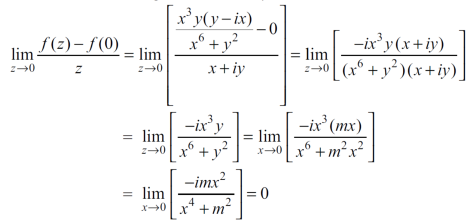
Suppose w = f(x,y) has continuous partial variables fx and fy and if x = x(t) and y = y(t) are differentiable function of t , then the composite function w = f(x(t), y(t)) is a differentiable function of t. we get,

Or,


Suppose w = f(x,y,z) has continuous partial variables fx , fy and fz and if x = x(t) and y = y(t) and z = z(t) are differentiable function of t , then the composite function w = f(x(t), y(t), z(t)) is a differentiable function of t. we get,

Or

Example-1: If w = x² + y – z + sin t and x + y = t then find

Sol. With x, y and z independent , we have

Therefore , we get

= 2x + cos ( x+ y)
Example-2: If w = x² + y – z + sin t and x + y = t then find

Sol. With x, t and z dependent , we have
y = t – x , w = x² + ( t – x ) + sin t
So that,

Let f(x,y) = 0
Where y = ∅(x)
By the chain rule , with x = x and y = ∅(x), we get


Here we assume that y is a differentiable funtion of x.
Example-1: if ∅ is a differentiable function such that y = ∅(x) satisfies the equation
x³ + y³ +sin xy = 0 then find  .
.
Sol. Suppose f(x,y) = x³ + y³ +sin xy
Then ,
fᵡ = 3x² + y cos xy
Fy = 2y + x cos xy
So ,

Example-2:

Sol. Take partial derivative on both side w.r. t. x , treat y as constant

Example-3: if x²y³ + cos y cos z = x² cos x sin y, then find 
Sol. Differentiate partially w.r.t. x and treat y as constant,
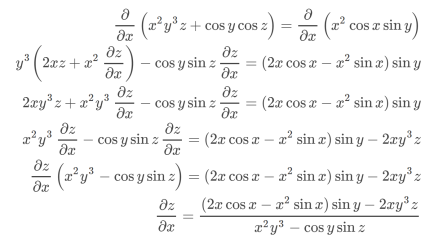
Suppose there is a function w = f(x,y,z) , which is the vector function,
Then the gradient of this function will be as follows ,
∇f = grad f = 
Example-1: determine the gradient of the function ,

Sol. We know that by def.
∇f = grad f = 
There are two variables only
We get, grad f

Example-2: determine the gradient of the function ,

Sol. We know that, the gradient for three vairables,
Grad f = 
So that, we get the gradient as below,

Example-3: determine the gradient of the function ,

Sol. We know that
Grad f = 
Then ,

The rate of a change of a function of several variables in the direction u is called directional derivative in the direction u.
We assume u is a unit vector
Suppose w = f(x,y,z) , then we can say that the directional derivative is the dot product of gradient and the vector u, such as
= 
Or
Suppose ∅( x,y,z) be a scalar point function and ‘s’ represents a distance from any point P(x,y,z) in the direction of unit vector  then
then  is called the directional derivative of ∅ in the direction of
is called the directional derivative of ∅ in the direction of 
Example: if ∅( x,y,z) = 3x²y - y³z² then find  at the point (1 , -2, -1).
at the point (1 , -2, -1).
Sol.  3x²y - y³z² )
3x²y - y³z² )
 3x²y - y³z² ) +
3x²y - y³z² ) +  3x²y - y³z² )
3x²y - y³z² )
 ------------------(1)
------------------(1)
At (1 , -2, -1), putting these values of x, y and z equation returns ,
 -12
-12
Example: determine the directional derivative of the function at point (1,3,-2) in the direction of the vector v = (3 , -1 , 4)

Sol. We know that, directional derivatives are given by the following expression
= 
Here we will find the magnitude ,



Let f(x,y,z) = 0 be the equation of surface S, now we want to find out the equation of tangent plane to S at the point P(x1 , y1 ,z1)
Let Q( x1+δx1 , y1+δy1 , z1+δz1) be the neighbouring point to P let the arc PQ be the δs and the chord PQ be δc , the direction cosine of PQ are,

As δs→0 , Q→ P and PQ tends to a tangent line PT, the direction cosines of PT are

Diff. F(x,y,z) = 0 w.r.t. ‘s’, we get

From these two equations it is clear that tangent whose direction cosines are

Is perpendicular to a line having direction ratios

Equation of tangent plane –

Equation of the normal to the plane-

Example: find the equation of the tangent plane and normal line to the surface.
x² + xy² + 3z² = 12 at (1 , 2 , -1)
Sol.

At point (1,2,-1),

We get the equations of the tangent plane at (1,2,-1) will be,

Equation of the normal will be,

When we measure the rate of change of the dependent variable owing to any change in a variable on which it depends, when none of the variable is assumed to be constant.
Let the function, u = f( x, y), such that x = g(t) , y = h(t)
ᵡ Then we can write,
 =
= 
= 
This is the total derivative of u with respect to t.
Change of variable-
If w = f (x, y) has continuous partial variables fx and fy and if x = x (t), y = y (t) are
Differentiable functions of t, then the composite function w = f (x (t), y (t)) is a
Differentiable function of t.
In this case, we get,
 fx (x (t), y (t)) x’ (t) + fy (x(t), y (t)) y’ (t).
fx (x (t), y (t)) x’ (t) + fy (x(t), y (t)) y’ (t).
Example-: let q = 4x + 3y and x = t³ + t² + 1 , y = t³ - t² - t
Then find  .
.
Sol. :  . =
. = 
Where, f1 =  , f2 =
, f2 = 
In this example f1 = 4 , f2 = 3
Also,  3t² + 2t ,
3t² + 2t , 
 4(3t² + 2t) + 3(
4(3t² + 2t) + 3(
= 21t² + 2t – 3
Example-2: Find  if u = x³y⁴ where x = t³ and y = t².
if u = x³y⁴ where x = t³ and y = t².
Sol. As we know that by definition,  =
= 
 3x²y⁴3t² + 4x³y³2t = 17t¹⁶.
3x²y⁴3t² + 4x³y³2t = 17t¹⁶.
Example-3: if w = x² + y – z + sint and x + y = t, find
(a)  y,z
y,z
(b)  t, z
t, z
Sol. With x, y, z independent, we have
t = x + y, w = x² + y - z + sin (x + y).
Therefore,
 y,z = 2x + cos(x+y)
y,z = 2x + cos(x+y) (x+y)
(x+y)
= 2x + cos (x + y)
With x, t, z independent, we have
Y = t-x, w= x² + (t-x) + sin t
Thus  t, z = 2x - 1
t, z = 2x - 1
Example-4: If u = u( y – z , z - x , x – y) then prove that  = 0
= 0
Sol. Let,

Then,

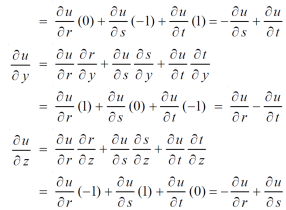
By adding all these equations we get,
 = 0 hence proved.
= 0 hence proved.
Example-5: if φ( cx – az , cy – bz) = 0 then show that ap + bq = c
Where p =  q =
q = 
Sol. We have,
φ( cx – az , cy – bz) = 0
φ( r , s) = 0
Where,
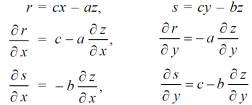
We know that,
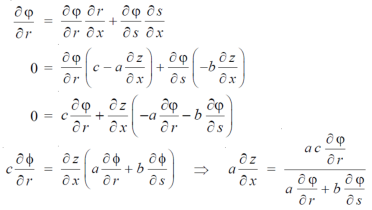
Again we do,

By adding the two results, we get


Let a function y = f(x) be defined in a δ – neighbourhood of a point x0 where δ > 0 then the function f(x) is said to be have a local maximum at point x0 if for all points x does not equals to x0 , belonging to the neighbourhood ( x0 – δ , x0 + δ) and the following inequality holds,
f(x) ≤ f(x0)
If the strict inequality holds for all points x ≠ x0 in some neighbourhood x0,
f(x) < f(x0)
Example-1: find the local extreme value of the function f(x) = 
Sol. The is differentiable for all x which belongs to real space.
We will find first derivative,

Put f’(x) = 0 , we get,

The maximum value will be,

Example-2: find the local extreme value of the function f(x) = - x² + 4x – 3
Sol. The function is differentiable everywhere on the set R.
We solve for ,
f’(x) = 0

Then,

Generally to calculate the stationary value of a function with some relation by converting the given function into the least possible independent variables and then solve them. When this method fail we use Lagrange’s method.
This method is used to calculate the stationary value of a function of several variables which are all not independent but are connected by some relation.
Let  be the function in the variable x, y and z which is connected by the relation
be the function in the variable x, y and z which is connected by the relation 
Rule: a) Form the equation

Where  is a parameter.
is a parameter.
b) Form the equation using partial differentiation is

(We always try to eliminate )
)
c) Solve the all above equation with the given relation 
These give the value of 
These value obtained when substituted in the given function will give the stationary value of the function.
Example1 Divide 24 into three parts such that the continued product of the first, square of second and cube of third may be maximum.
Let first number be x, second be y and third be z.
According to the question
Let the given function be f
And the relation 
By Lagrange’s Method

 ….(i)
….(i)
Partially differentiating (i) with respect to x,y and z and equate them to zero

 ….(ii)
….(ii)

 ….(iii)
….(iii)

 ….(iv)
….(iv)
From (ii),(iii) and (iv) we get

On solving

Putting it in given relation we get

Or 
Or 
Thus the first number is 4 second is 8 and third is 12
Example2 The temperature T at any point  in space is
in space is  .Find the highest temperature on the surface of the unit sphere.
.Find the highest temperature on the surface of the unit sphere.
Given function is 
On the surface of unit sphere given  [
[ is an equation of unit sphere in 3 dimensional space]
is an equation of unit sphere in 3 dimensional space]
By Lagrange’s Method

 ….(i)
….(i)
Partially differentiating (i) with respect to x, y and z and equate them to zero
 or
or  …(ii)
…(ii)
 or
or  …(iii)
…(iii)
 …(iv)
…(iv)
Dividing (ii) and (ii) by (iv) we get

Using given relation 
Or 
Or 
So that 
Or 
Thus points are 
The maximum temperature is 
Example3 If  ,Find the value of x and y for which
,Find the value of x and y for which  is maximum.
is maximum.
Given function is 
And relation is 
By Lagrange’s Method

 [
[ ] ..(i)
] ..(i)
Partially differentiating (i) with respect to x, y and z and equate them tozero

Or  …(ii)
…(ii)

Or  …(iii)
…(iii)

Or  …(iv)
…(iv)
On solving (ii),(iii) and (iv) we get


Using the given relation we get 



So that 
Thus the point for the maximum value of the given function is 
Example4 Find the points on the surface  nearest to the origin.
nearest to the origin.
Let  be any point on the surface, then its distance from the origin
be any point on the surface, then its distance from the origin  is
is

Thus the given equation will be

And relation is 
By Lagrange’s Method

 ….(i)
….(i)
Partially differentiating (i) with respect to x, y and z and equate them to zero

Or  …(ii)
…(ii)

Or  …(iii)
…(iii)

Or 
Or 
On solving equation (ii) by (iii) we get

And 
On subtracting we get 
Putting in above 

Or 
Thus 
Using the given relation we get
 = 0.0 +1=1
= 0.0 +1=1
Or 
Thus point on the surface nearest to the origin is 